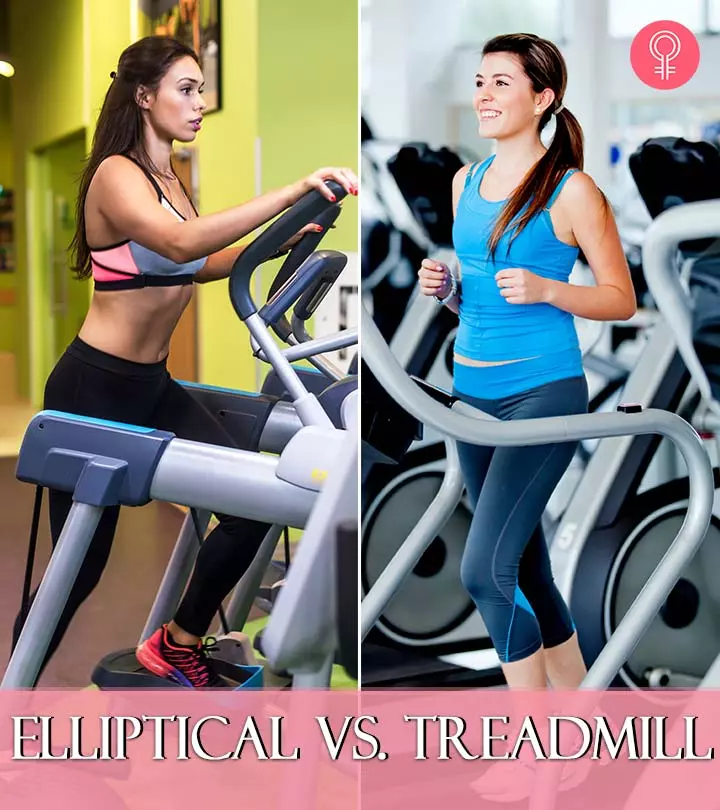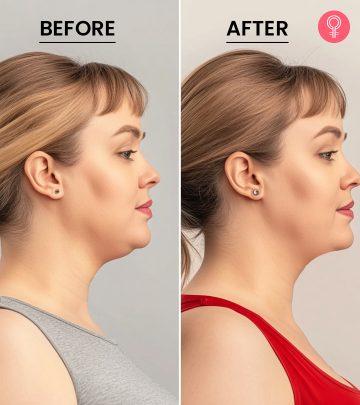Exercises For Heart Health: 11 Effective Workouts To Try
It is, after all, possible to reduce your chances of a stroke and stay healthy for long.

Image: iStock
Staying healthy is essential. Exercises for heart health are crucial for fulfilling that purpose. Leading a sedentary life and bad eating habits increase the risk of heart disease and stroke. The American Heart Association (AHA) suggests that staying active and quitting unhealthy habits like smoking are added factors to keeping your heart in top shape (1), (2). However, if you have a heart condition, you must avoid certain exercises (3). This article lists some safe exercises for keeping your heart healthy and young. It also tells you which ones to avoid. Read on!

If you are at risk for stroke or have a history of heart conditions, make sure you work very closely with your healthcare providers on a plan. “Any online or general recommendations,” says David Rosales, a personal trainer, “should not supersede personal directions from certified professionals who know you and your situation best. Especially when it comes to medical conditions, a personalized program is often the best option.”
In a study that analyzed the health records of over 50,000 patients, people who got at least 500 metabolic equivalent minutes of activity per week were 17% less likely to face a cardiac problem. The study was presented at the American College of Cardiology’s 71st Annual Scientific Session. People with anxiety or depression issues had a major benefit with exercising, with a 22% risk reduction compared to the 10% risk reduction in those without the above conditions.
 Exercises For Heart Health
Exercises For Heart Health- Frequency: Daily
- Benefits: Reduce the risk of cardiovascular mortality and type 2 diabetes, promote weight loss, increase insulin sensitivity, and reduce blood pressure
- Equipment Needed: Resistance bands, dumbbells, yoga mat, and barbells
- Space Required: Small area
- Assistance Required: No
- Who Should Avoid: People with joint problems, acute heart issues, or high blood pressure
In This Article
Benefits Of Exercise For Heart Health

You will be surprised to know that exercising can reduce the risk of or potentially reverse many other health conditions. Here’s a list of benefits of exercising regularly for your heart (2), (3), (4):
- Reduces the risk of cardiovascular mortalityi Deaths caused in a specific region by cardiovascular diseases like myocardial ischemia, heart failure, or cardiac arrest.
- Helps reduce blood pressure
- Promotes weight loss and prevents obesity
- Reduces the risk of type 2 diabetes
- Increases insulini A hormone released by the pancreas that is responsible for regulating the blood sugar levels in the body. sensitivity
- Helps reduce bad cholesterol (LDL) and increase good cholesterol (HDL)
- Decreases inflammation in the body
- Lowers resting heart rate and risk of thickening of heart muscles (cardiac hypertrophy)
- Improves vascular wall function and the ability to provide oxygen to the muscles
- Increases exercise tolerance
- Improves the quality of life of people with heart conditions
 Did You Know?
Did You Know?There are more reasons to exercise than not. Which exercises are good for keeping the heart in good shape? Keep scrolling to know how to improve your overall wellness with these exercises.
Key Takeaways
- Aerobics or cardio increases heart rate, improves blood circulation and overall strength, endurance, and fitness and the AHA recommends 30 minutes of cardio five days a week to improve cardiovascular health.
- Strength training is great for improving heart muscle strength and toning the body and doing 30 minutes of strength training two days a week can be highly beneficial.
- Balance and flexibility exercises are also good for improving heart rate, reducing the risk of cardiovascular diseases, and enhancing muscle tone.
11 Best Exercises For A Healthy Heart
The benefits of physical exercise are numerous, especially for heart health. The only thing you need to do is not overdo it, and if you are a beginner, get expert guidance for the right approach. Here’s a variety of exercises for you to choose from to keep your heart healthy.
- Aerobic Exercises
Aerobics or cardio gets the heart rate up. It also improves blood circulation and overall strength, endurance, and fitness gradually. The AHA recommends 30 minutes of cardio five days a week to improve cardiovascular health (5). Here’s a list of aerobic exercises effective for boosting heart health.
1. Walking
According to the American Heart Association (AHA), moderate to brisk walking is one of the most effective outdoor activities you can do and is good for heart health.
Do a mix of moderate and brisk walking to improve cardiovascular output without stressing the lungs or tiring yourself.
As the AHA recommends, “walk with purpose.” Whether you are stressed out, need some air, or want to think of an idea – take a walk. You may take your pet or baby out for a stroll, walk for a social cause, or with a group of friends – it is great for your physical and mental health. Don’t forget to take a bottle of water along!
Bob Butler, a blogger, shares his experience of trying to get back to running after experiencing a stroke: “The 2-year effort to return to running after my stroke certainly tells a compelling story of patience, persistence, and perseverance (i).” He continues, “One year and a half of continuous traditional physical therapy allowed me to progress to what could be considered a best-practices outcome. I could walk very slowly and without a walker or cane, and ultimately did not need an ankle foot orthotic (AFO) or special shoes with a slider plate on the front sole of the affected side shoe.”
 Quick Tip
Quick Tip2. Cycling
Biking or bicycling is great low-impact cardio to keep your heart healthy.
Research shows that bicycling can help reduce cardiovascular disease (CVD) risk in middle-aged men and women (6). Another study showed that people who cycled had an 11-18% lower risk of coronary heart disease (7). Instead of a car, use a bicycle to commute to nearby places. This will get your heart pumping and tone the muscles of your calves, thighs, and glutes.
3. Playing A Sport

Do you enjoy playing a sport? Or have you always wanted to? Then, it’s time to get the adrenalinei A hormone released by the adrenal glands that is responsible for stimulating the body's fight-or-flight response. pumping with a lot of serotonini A neurotransmitter and a hormone that commonly has its role in stabilizing one's mood. . Playing a sport (like badminton, tennis, or basketball) increases circulation and oxygen flow and gets the heart pumping, which helps improve heart health. However, if you have an existing heart condition, avoid extreme exertion and talk to your doctor before playing a sport or joining a group. Your doctor may suggest some low-impact exercises to help you stay fit.
4. Swimming
Swimming is a full-body exercise that helps improve cardiovascular output, muscle strength, endurance, and fitness.
However, it may not be ideal for all. If you have an existing heart condition, talk to your doctor to know if you can swim.
5. Household Chores
Yes, you do not even need to go to a gym to stay healthy. Household chores are a great way to keep moving and stay active. Activities like cleaning, dusting, rearranging the kitchen or wardrobe, watering the plants, etc., are great ways to keep your heart healthy.
- Strength Training
Apart from aerobic exercise, include strength training in your routine. This physical activity is also great for improving heart muscle strength and toning the body. Doing 30 minutes of strength training two days a week can be highly beneficial. Here are the types of strength exercises you can do.
6. Resistance Band Exercises
Resistance training is a great way to add a challenge to your workout routine. A study showed that resistance exercise could lower the risk of cardiovascular diseases (CVD) in women of any age and reduce body fat, blood sugar, and total cholesterol (8). Resistance bands come in various thicknesses, and it is best to start with the one that provides the most resistance for your fitness level. Here are a few resistance band exercises you can do.
7. Weight Training

Love working out with dumbbells, barbells, and the Smith machine? Well, they are good for keeping your body and heart in shape. Yes, weight training was considered unsafe for people with heart disease, but new findings show that it is safe and effective. Talk to your doctor and do the weight training under the supervision of a certified and experienced fitness professional. Exercises customized to your needs can get you better results.
8. Bodyweight Exercises
If you do not like to lift weights, you can do bodyweight training. In this workout, you lift your body’s weight instead of dumbbells or weight plates. It can include moderate to high-intensity exercises like push-ups, mountain climbers, high jumps, squats, etc. Your trainer will design a safe and effective bodyweight training program, depending on your fitness level and heart condition.
- Balance And Flexibility
Balance and flexibility exercises are also great for improving heart rate, reducing CVD risk, and enhancing muscle tone. Here are some exercises you can do:
9. Stretching
Stretching the muscles after your workout routine helps cool them down (walk or jog to warm up the muscles before exercising). You can also do exercises like touching the toes, calf stretches, and neck and arm stretches while sitting. Stretch for a good 10-15 minutes every day.
10. Yoga

Yoga asanas and pranayama are great for improving heart health. They improve muscle tone and lung capacity while relieving stress. Scientists state that yoga is a useful lifestyle intervention for managing cardiovascular diseases (9). Rehabilitation trainers also believe that yoga adds value to recovery therapy for people with CVD (10).
11. Arm Circles
Arm circles are a weight-free workout that focuses on your shoulders and upper arms. It is popular in warm-ups performed during weight training and other sports. People usually do it until they feel a burn. But you may also consider ten-second movements to be one set, and each circle can be considered one repetition. This exercise may also help improve the heart rate and circulation in elderly individuals (11).
How To Do
- Stand, keeping your feet shoulder-width apart. You also may sit on an exercise mat.
- Stretch your arms out parallel to the ground.
- Move your arms in small, controlled circles.
- Gradually increase the size of the circles until you sense a stretch in your triceps.
- Change the direction of the circles after 10 seconds.
Note: You do not have to perform all these exercises at once. Instead, mix and match them to create a workout plan tailored to your fitness needs. Ensure that you enjoy all the activities you choose. This will make it easier for you to stick with them and get the most out of your workout.
Remember, it is not possible and advisable to do all of these exercises or sports at once. What is the ideal frequency for these exercises? Find out in the following section.
How Much And How Often To Exercise?
The American Heart Association recommends 150 hours of moderate-intensity and 75 minutes of vigorous exercise (12). This means you can either do 30 minutes of cardio for five days or 50 minutes of cardio for three days and 35-40 minutes of strength training or stretching exercises.
Customize your cardio routine according to your heart’s condition and lifestyle. Start with three days of cardio and one day of strength training/yoga. Increase the frequency to 4-5 days of cardio and 2-3 days of weight training as you progress.
However, if you have an existing heart condition, you must avoid doing a few exercises. Scroll down to find out.
Which Exercises To Avoid
- High-intensity interval training
- Running marathons
- Taking part in triathlons.
Even if you don’t have a pre-existing heart condition, always pay attention to your body’s signals. If you feel uneasy during any exercise, it’s best to avoid it. If you ever experience chest pain, shortness of breath, or dizziness while working out, it’s crucial to consult a doctor immediately.
Stressing the arteries and heart is not ideal. If you have a heart condition, it is best to talk to a fitness professional before starting any exercise. You can take the following precautions while exercising.
Precautions To Take

- Talk to your doctor before starting any exercise.
- Do supervised exercises.
- Join an exercise group that specializes in cardiovascular therapy.
- Always warm up before exercising.
- Take time to do cool-down stretches post-workout.
- If you feel breathless or experience sharp pain, stop immediately and rest.
Doing exercises for heart health is highly recommended. This holds particularly true in the case of those following a sedentary lifestyle and unhealthy diet. From reducing blood pressure and promoting weight loss to decreasing inflammation and cholesterol levels, the benefits of the exercises listed above are outstanding and heart-healthy. However, high-intensity interval training, marathons, and triathlons are not suitable for anyone with a heart condition. More importantly, consult a doctor before starting these exercises, and do not forget to warm up for at least 10 minutes. For better results, quit smoking and make healthy changes in your diet.
Frequently Asked Questions
Can a weak heart be reversed?
Yes. Some exercises and treatments can help grow new muscle cells and blood vessels to allow your heart to work more effectively.
Can exercise reverse heart blockage?
Yes. It is possible to reverse heart blockage through regular exercises (13).
Is jogging good for your heart?
Yes. Jogging is one of the exercises to lower blood pressure, which reduces the risk of stroke and heart attack by lowering BMI, cholesterol, and blood pressure.
Take charge of your cardiovascular health. Check this video and get ready to boost your stamina and vitality with these 3 exercises designed to improve heart function
Personal Experience: Source
StyleCraze's articles are interwoven with authentic personal narratives that provide depth and resonance to our content. Below are the sources of the personal accounts referenced in this article.
i. If You Can’t Walk, Run!https://overcomingstroke.wordpress.com/2015/08/24/if-you-cant-walk-run/
References
Articles on StyleCraze are backed by verified information from peer-reviewed and academic research papers, reputed organizations, research institutions, and medical associations to ensure accuracy and relevance. Read our editorial policy to learn more.
- Cardiovascular Disease
https://www.ncbi.nlm.nih.gov/books/NBK535419/ - Exercise and Cardiovascular Health
https://www.ahajournals.org/doi/full/10.1161/01.CIR.0000048890.59383.8D - Cardiovascular Effects and Benefits of Exercise
https://www.ncbi.nlm.nih.gov/pmc/articles/PMC6172294/ - Effects of Exercise to Improve Cardiovascular Health
https://www.ncbi.nlm.nih.gov/labs/pmc/articles/PMC6557987/ - American Heart Association Recommendations for Physical Activity in Adults and Kids
https://www.heart.org/en/healthy-living/fitness/fitness-basics/aha-recs-for-physical-activity-in-adults
- Bicycling to Work and Primordial Prevention of Cardiovascular Risk: A Cohort Study Among Swedish Men and Women
https://www.ahajournals.org/doi/10.1161/JAHA.116.004413 - Prospective Study of Bicycling and Risk of Coronary Heart Disease in Danish Men and Women
https://www.ahajournals.org/doi/full/10.1161/circulationaha.116.024651 - The association between resistance exercise and cardiovascular disease risk in women
https://www.ncbi.nlm.nih.gov/labs/pmc/articles/PMC4369452/ - Role of Yoga in Cardiac Disease and Rehabilitation
https://pubmed.ncbi.nlm.nih.gov/31021995/ - Yoga in cardiac health (a review)
https://pubmed.ncbi.nlm.nih.gov/15616408/ - Differences in autonomic modulation of heart rate during arm and leg exercise
https://pubmed.ncbi.nlm.nih.gov/10451789/ - How much physical activity do you need?
https://www.heart.org/en/healthy-living/fitness/fitness-basics/aha-recs-for-physical-activity-infographic - Reversing the Cardiac Effects of Sedentary Aging in Middle Age—A Randomized Controlled Trial
https://www.ahajournals.org/doi/10.1161/CIRCULATIONAHA.117.030617
Read full bio of David Rosales
Read full bio of Ravi Teja Tadimalla
Read full bio of Payal Karnik



























Community Experiences
Join the conversation and become a part of our empowering community! Share your stories, experiences, and insights to connect with other beauty, lifestyle, and health enthusiasts.